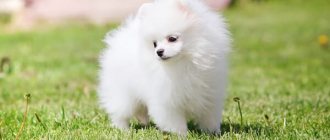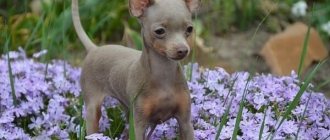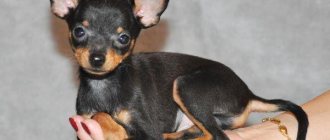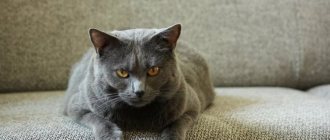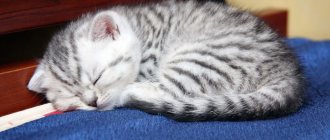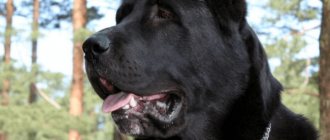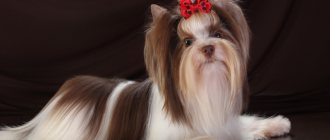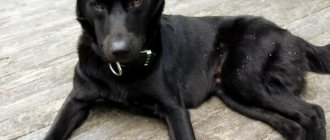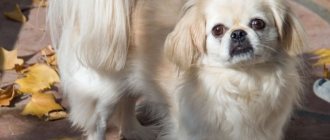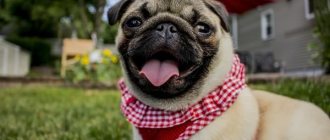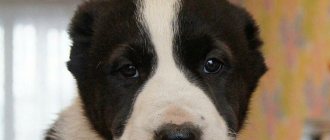Among ordinary, standard pit bulls, you cannot find dogs with a beautiful and spectacular merle color.
However, on the Internet you can often see photographs of merle-colored pit bulls.
These dogs look very unusual and therefore attract everyone's attention.
However, if the merle color is unacceptable according to the standard, then where do such dogs come from?
It's simple: we are talking about a new, very rare variety of this breed, called the Albanian pit bull.
What do they look like in the photo?
There is no separate breed called “Albanian pit bull” . However, this does not mean that merle pit bulls do not exist.
Such puppies can be born, but will be considered a breeding marriage and, of course, admission to exhibitions and breeding is closed for them.
Externally, the so-called Albanian pit bulls look very similar to ordinary American pit bull terriers, the only thing that distinguishes them from standard representatives of the breed is their unusual marbled color, in which black or brown uneven shapes are located on a light gray or light beige background, complemented by white markings spots.
In addition, they can be slightly larger than standard dogs of this breed..
Let's sum it up
The Albanian Pitbull is a dog that you will not find in the registry of officially registered breeds. Moreover, you will not find offers for the sale of puppies on Avito, on the websites of famous nurseries, etc. This is because this type of animal was bred:
- unofficially;
- in violation of breed standards;
- with irreversible and dangerous changes in the nervous, immune and other systems of the animal’s body.
In this case, the beautiful coloration equals the high level of danger that you could potentially be exposed to if your pet were an Albanian Pitbull. You should not look for a meeting with this breed; pay attention to less exotic and more stable dogs.
Do you like pit bulls? Give preference to a standard representative of this breed and instead of a bunch of problems you will find a loving friend who will stand by your side all his life
Origin story
Attempts to breed merle pit bulls have been made in the United States for several decades..
Moreover, the purpose of breeding these dogs was not only a beautiful and spectacular color, but also to improve strength, hunting and protective qualities.
For this purpose, breeding work was carried out, which consisted of interbreeding pit bull terriers with Catahoula leopard dogs - a very rare and little known breed outside the United States, the representatives of which are distinguished by their unusual merle color.
Moreover, the origin of the Catahoula leopard dog is not known exactly.
It is assumed that it came from crossing local Indian dogs with red wolves, there is also a version that its ancestors were dogs of conquistadors and, possibly, Beaucerons - a fairly popular herding breed.
The so-called Albanian pit bulls are currently not recognized by any cynological federation in the world.
French bulldog colors
The breed standard allows the following colors:
- brindle;
- spotted;
- pale yellow.
The remaining colors (white with black spots, mouse, smoky, liver, blue, tan, pure black) are defective, which does not affect their popularity among connoisseurs of the breed.
The most common colors are white, blue, fawn and brindle.
Below you can see descriptions of what this or that color looks like, as well as photos with examples.
White
Purely white color is extremely rare.
As a rule, the color is represented by snow-white or milky-white shades. The spots on the dog's body can be any color (but not black), and there is often a dark mask on the face. This color is genetically recessive.
Representatives of the white coloration have good immunity.
Gray
Gray coat color is widespread.
The color is represented by gray shades of varying degrees of severity (from light gray to metallic), monophonic. The coat is short, shiny, and the hairs are the same gray color throughout.
Dogs may have small white spots on the chest (but most often there are no spots or a mask).
Redheads
The red color is a common variation of the fawn color.
Dogs have a black mask on their face. The wool is uniformly colored in a rich copper-red shade. White spots are allowed on the puppy's body, except for the chest, neck and belly.
Blue
Blue Bulldogs have not been recognized as a standard color, but are becoming increasingly popular.
Blue coat color is a variation of gray and comes in various shades, but the most common is “blue clay color.” Often this beautiful color is combined with blue eyes.
This color is monochromatic, but puppies may have small spots of white on the chest.
Black
Black coat color is not a single color - in fact, dogs have variegated colors of varying degrees of intensity (variations of dark brown, brown and tan, black and tan). The intensity of the shade depends on the genetic characteristics of the dog.
Beige
The beige color of the breed was recognized as standard only in America.
NOTE! The beige color is similar to the fawn color, but differs from it in the different coloring of the tip of the nose, eyelids and lips of the dog. With a beige color they have a cream color, with a fawn color they are black.. Beige representatives do not have a black mask and are born light red (evening out and lightening the tone to beige occurs gradually)
Beige representatives do not have a black mask and are born light red (evening out and lightening the tone to beige occurs gradually).
Chocolate
Chocolate color is a uniform, rich brown or brown-brown color with a slight shine. Variations in shade are possible, but it will always be monochromatic.
Chocolate-colored dogs have longitudinal white spots on the neck and belly, and there is no mask on the face.
Merle color
Merle (merle) is a marbled coat color. It is a genetically dominant trait and is not recognized as a standard.
Merle coloring is uneven, tricolor and is represented by fuzzy spots of various sizes and shades, most often alternating coffee, white and brown. There is usually no mask.
Often representatives of this color have heterochromia (different colors of the iris), as well as other genetic abnormalities.
Brindle
Brindle is the most common color. It is represented by a variegated alternation of red and black stripes on the dog’s body. Light (“milky”) markings are allowed on the chest and neck; there is a dark mask on the muzzle.
Brindle color is inherited as a dominant trait. Puppies with this coloring are distinguished by good health, mobility and unpretentiousness.
Fawn
The fawn color is represented by a rich range of colors from light coffee to red. Within each color there can be both light and dark fawn shades.
A fawn colored dog may have a dark mask or a small number of small white patches on the chest and neck. The belly is white.
With this color, the hairs have a red color of varying degrees of intensity and length. Short ones are lighter, long ones are darker. The tips of the hairs are often gray in color.
Any variation of fawn color must be uniform. Fawn color can be either recessive or dominant. Varieties: fawn brindle (fawn color dominates) and variegated fawn (black color dominates).
Marriage or breed
The merle color is considered a breeding defect among American pit bull terriers, of which Albanian pit bulls are a variety.
Expert opinion
Kozhevin Semyon Kirillovich
Expert dog handler.
“Pit bull terriers with merle or leopard coat patterns look very unusual, so it is not surprising that dogs with this color have become incredibly popular on the Internet. However, we should not forget that it is considered a breeding defect among standard American Pit Bull Terriers and that it is not without reason that this coat color is considered prohibited in a breed where almost all other colors are acceptable. Genetically, merles can be associated with health and mental problems, and while there are breeds in which these pathologies are rare, pit bulls are not one of them. Therefore, purchasing a so-called Albanian pit bull is a kind of lottery, the winning in which will be the acquisition of a healthy animal with an unusual color, and the losing will be the purchase of a dog with problematic health and an unbalanced psyche. Whether to take risks or not is up to each future owner, but experts still recommend refraining from purchasing such dogs.”
Is it worth the risk?
Pit bull terriers are dogs with a special character. They need education, otherwise problems will arise in communicating with people. While a standard breed can be trained, the behavior of artificially bred dogs cannot be predicted. The result of selection may be unpredictable, both in terms of the dog’s health and behavior.
According to the standard, the M gene is found in some varieties of shepherd dogs, dachshunds and collies
The M gene very often affects the animal's ability to reproduce further. An albino pit bull is one of the options for how the introduced gene can behave. The birth of a white dog is considered one of the most harmless deviations.
Note! Pigment cells are formed along with cells of the nervous system, so deviations in their development can provoke mental illness.
Since pit bulls are quite large dogs, their uncontrollable nature can become a real danger to the environment. Considering the above risks, you need to think twice before buying or breeding an unusual breed.
Character traits
Albanian pit bulls differ from standard dogs only in their unusual coloring, but not in their temperament. They are just as confident, energetic and active.
These are very hardy, strong and practically insensitive to pain animals, characterized by well-developed hunting instincts and innate aggression towards other people's dogs..
Like standard pit bull terriers, representatives of the Albanian variety of this breed are always ready for action, they are not afraid of anyone and are ready to fight with any opponent, even if they are several times their size.
CAREFULLY!
Aggression towards people in these dogs should be unacceptable in principle; moreover, all attempts to develop it in an Albanian pit bull can lead to very sad consequences, up to and including complete uncontrollability of the pet’s behavior.
Due to characteristics associated with the merle color gene, Albanian pit bulls can be mentally unstable and more aggressive than dogs of other, standard colors.
The opinion of dog handlers
The opinions of dog handlers regarding these dogs are divided into two camps. Some consider the idea to be successful and have a positive attitude towards the development of a new breed. In their opinion, it only takes time to improve the dogs and eliminate the possibility of deviations and defects.
Others believe that the idea of breeding an Albanian pit bull is doomed and will not be successful. A gene mutation can harm aggressive dogs and make their temper even worse. Experts say that such dogs cannot be kept at home, but only in kennels.
Advantages and disadvantages
pros:
- Beautiful, spectacular and very unusual color.
- Strength and endurance.
- Well developed hunting instincts.
- Great reaction.
- We are always ready to take active action: for example, a peacefully dozing pit bull can take off at lightning speed in the next moment and attack the enemy.
- Suitable for almost any sport, be it agility or dragging weights.
- Intelligence, intelligence and fairly good learning ability.
Minuses:
- Stubbornness, sometimes reaching the point of obstinacy.
- Increased zoo aggression.
- The need for early socialization, as well as proper education and professional training.
- You cannot teach skills related to aggression towards people, in particular, detaining and escorting a violator.
- They do not like loneliness and need constant communication with their owners.
- Risk of health or mental problems associated with merle genetics.
Albanian pit bulls are not suitable as pets for people who have never owned a serious dog breed in their home before..
It is also necessary to take into account that these dogs, more than standard pit bulls, may be predisposed to increased viciousness, aggression and behavioral disruptions.
Only a strong, self-confident person who is well versed in dog breeding and knows how to properly raise a pet so that in the future it does not become a source of many problems or even accidents can become the owner of an Albanian pit bull.
*Ticking and merle are not the same thing! They are so often confused.
What is mottling (ticking)?
Tick refers to small spots (specks) on the white areas of a dog's coat. Imagine a dog covered with a white cloth with holes cut into it. The speck is the base color that can be seen through the holes in the fabric. The basic color of the dogs (without white), may have specks. However, we will not be able to see it as it is only visible in areas with white fur.
Marking is characteristic of many dog breeds, but it is best known from the example of Dalmatians and English setters. Also, many spaniels can have a speckled color.
In the photo there is a teak (speckled) dog - Jasmine Pete Right
Dimensions, weight and other distinctive features
| Options | Data |
| Height | Can range from 46 to 66 cm in males and from 43 to 61 cm in females. |
| Weight | Depending on gender and height is 14-37 kg |
| Head | Medium in length, shaped like a rectangle. The skull is wide and flattened in the frontal part, the cheekbones are well defined. The jaws are strong, well developed, and have a scissor bite. |
| Muzzle | Square, quite deep and voluminous. |
| Ears | Set high, left natural (semi-erect or rose-shaped) or docked. |
| Eyes | Almond-shaped or round, low-set. Their color can be any, including bluish, typical of the merle color. |
| Neck | Muscular and slightly convex, but at the same time dry, widening downward. |
| shoulder blades | Set obliquely, strong and well muscled. |
| Back | Not long, rather wide and strong, slightly sloping towards the base of the tail. |
| Rib cage | Deep and voluminous, but not too wide. |
| Forelegs | Straight and parallel with strong, vertical pasterns. |
| Hind limbs | With well-muscled, fairly long thighs and regular joint angles. Tail |
| Tail | Low set, fairly short and not too thick, tapering towards the end. In a state of excitement and when moving, the dog raises it to the line of the back. |
| Wool | Without undercoat, short, harsh, shiny and close-lying. |
The weight of the dog should correspond to its height, but in general the Albanian pit bull looks like a strong, strong and muscular dog.
Dangerous aggressor French bulldog
Tightly built dogs with a hilarious facial expression and protruding, large ears are most similar to the Cheburashka. Short-haired dogs represent assertiveness and courage, but they never attack first.
They can be quite serious guards, and even train in protective guard service. Little fighters tend to dominate in the family and strive to take the closest position to the owner.
- Height: from 30-31 cm.
- Weight: 9.5-13 kg.
- Color: brindle, white-fawn, spotted, cream.
- Price: 18-35 thousand rubles.
A fluffy ball covered with hair is a portrait of a Japanese Chin. Beautiful, graceful dogs with dark, speaking eyes are always the center of attention and are children's favorites and devoted friends.
Cheerful, with a great sense of humor and friendly to other animals, dogs of this breed are well trained, non-intrusive and affectionate.
- Height: 22-25 cm.
- Weight: 2.2-5 kg.
- Color: bicolor, the main background is white with spotted inclusions of black or brown.
- Price: from 15 to 25 thousand.
Basic colors
- Blue merle (blue merle) . Black spots of uneven shape, scattered on a light grayish background, complemented by white markings.
- Red merle (red merle) . Spots of a brownish or reddish hue, located on a pale brown, beige or fawn background. This color also has white markings that set off the main color of the coat.
Many Albanian pit bulls have more or less pronounced tan, and the brighter it is, the more impressive the dog looks.
Description of colors
Their coat has a rather dense structure, the guard hairs are straight, which is why they appear so voluminous.
The undercoat is so thick that it keeps the coat in an upright position.
The hair located near the dog's muzzle and on the paws is short with a dense structure. On the body they are long and thick, but most of all in the area of the mane, riding breeches and tail.
This breed has four main colors, but their shades are varied and rich. The main varieties are as follows:
- black with white markings (but not the back and body);
- sable;
- a combination of black and sable colors - tricolor;
- blue merle or merle.
In all varieties (and for black it is mandatory) white spots are allowed on the forehead, collar area, chest, tips of the paws, and tail. More stringent criteria for blue merle are that there must be no gray color, low color saturation or absence of black spots or dull color.
Black and black and white
This variety is quite common among Shelties. Representatives of this breed with this combination of colors look very impressive. The absence of the usual tan on the head of a black dog looks unusual and very unusual.
At exhibitions, this color variety often takes prizes. I don’t know why this happens, but most likely it is this color that most emphasizes all the features of the exhibition specimen
In any case, if you dream of winning at an exhibition, I advise you to pay more serious attention to this option
Sable
This color is one of the most beloved among admirers of this breed. Sable has a fairly large palette of shades: from light golden to a pronounced mahogany tone. In puppies with this coat color, the color rarely changes with age.
Dogs with sable coloring do not have a dark “cap” on the head with a clear V-shaped border and a darker shade of fur on the back. They may have a small amount of black hair, but the overall coloring will be even. You will get sable puppies if at least one of the parents has this color.
Tricolor
The tricolor is a combination of rich black with bright red tan marks and white spots, creating a spectacular contrast. Puppies with such a tricolor coat do not acquire new shades with age. Tricolor can be combined with any of the main colors.
It is undesirable for this variety to have a brown or rusty tint to the black coat. However, this color can appear in a dog after the coat has faded in the sun. Then the black color will become saturated again.
Marble or Blue Merle
The main color is white or blue. The other should be darker, a deeper shade, almost black. The marks should be small in the form of dots, blots or stripes.
White spots are acceptable in the blue merle color. The peculiarity of the coat of such dogs is that the main part of the hair is light, and its end is dark.
Other varieties
Non-standard color combinations are obtained when breeding Shelties that have different, incompatible colors. Other varieties:
- Sable Merle - a combination of sable and blue merle;
- white merle - white merle.
Shelties with this type of coat will not be able to take part in shows. However, their non-standard appearance sets them apart from other representatives of this breed.
Life expectancy and what diseases are they susceptible to?
Albanian Pit Bull Terriers are predisposed to only a few diseases, such as:
- Allergy.
- von Willebrand disease
- Hemangioma or histocytoma of the skin.
- Hypothyroidism.
- Volvulus or bloating of the stomach and intestines.
- Diseases of the musculoskeletal system, including dysplasia.
- Aortic stenosis.
However, because the double merle gene can be associated with a variety of health problems, these dogs may be susceptible to other ailments, such as congenital blindness and deafness, as well as weakened immune systems.
IMPORTANT!
Among pit bulls of this variety, early mortality is high and there are frequent cases of the birth of offspring suffering from developmental defects, often incompatible with life.
That is why most professional breeders consider it inappropriate to specially breed such dogs and, as a rule, discard them from breeding.
Standard American pit bulls live 12-15 years, but as for the Albanian variety of this breed, the life expectancy of its representatives depends on factors such as heredity and the state of the immune system.
What is double merle
When two individuals with the merle pattern are bred, each puppy in the litter has a 25% chance of inheriting the gene from both parents. The resulting offspring is called double or homozygous merle. In breeds that have white markings on the head, neck, paws, belly, and tip of the tail (Irish, Collie, Border Collie, Scottish, Australian Shepherds), double marbling is easy to recognize at first glance. They usually only have a few spots. Even the standard marbles of these rocks have a slightly greater white accent than their unmarked siblings (though this is not the rule).
Welsh Corgi Double Merle
Additional information . Ordinary merles are healthy dogs, but “doubles” may have varying degrees of impaired vision and hearing. This is because at double the dose the merle gene causes too much pigment restriction. The structures responsible for hearing and vision are also formed from the same cells as pigment cells.
Basic rules of care
It is recommended to brush Albanian pit bulls with a brush for short-haired dogs or a special mitten once a week. They are bathed no more often than once every 2 months, and it is recommended to use hypoallergenic shampoos for short-haired dogs.
Ears and eyes should be examined regularly, but cleaned only when they become dirty and, preferably, using special cleaning products..
You can brush your pet's teeth 1-2 times a week with a toothbrush and dog toothpaste, or simply give him chewing toys or treats designed to remove plaque.
Nails are trimmed with nail clippers if they grow excessively and begin to curl inward, causing discomfort to the dog.
Albanian Pibuls are not intended for year-round outdoor keeping because due to their short hair and complete absence of undercoat, they do not tolerate frost well..
How much does it cost to own a dog?
When getting a dog, you immediately need to purchase a collar, leash, bed, brush and other accessories. In this case, you will have to shell out 5-10 thousand rubles.
The maintenance itself is not too expensive - every month the dog will eat food worth several hundred rubles, maximum a couple of thousand - this largely depends on the diet. Homemade food is cheaper than elite, store-bought food.
How much money do you need for care products? This mainly includes anti-parasite medications, shampoo and wipes.
Note! A pit bull doesn’t need a lot of shampoo, so monthly costs will be no more than 300-500 rubles.
How to feed?
The basis of the diet of such an active dog should be protein products of animal origin.
Meat or meat products are best suited for this, which are recommended to be supplemented with rice, buckwheat or oatmeal, as well as fermented milk products, raw or boiled vegetables.
In addition, vitamin and mineral supplements should be added to your pet's food, but this should be done only after consultation with a veterinarian.
If the Albanian pit bull eats ready-made food, preference should be given to high-quality hypoallergenic food with a high protein content.
How to choose?
Despite the fact that the breed is not officially recognized, it is recommended to buy such a puppy only from a kennel that breeds pit bulls.
At the same time, it is very important that the future pet comes from dogs of healthy lines and, of course, that one of its parents is not merle, since offspring born from two merles are usually characterized by an unstable psyche and weak immunity, in addition, they may there may be many hidden congenital malformations, which will certainly cause health problems for the pet in the future.
Considering that Albanian pit bulls are predisposed to congenital blindness and deafness, it is recommended to pay special attention to checking the health status of the selected puppy, and, preferably, to have it examined in a clinic.
You also need to observe the kids for some time to make sure that they have a stable psyche and are not overly aggressive.
You should not adopt a puppy that angrily attacks other dogs or, especially, tries to attack people..
He almost certainly has serious mental problems, which are not always possible to correct even with the help of proper education and professional training.
Albanian pitbull for sale
Unfortunately, the essence of man is such that, despite all the warnings and reasonable arguments, the inner desire turns out to be stronger. So, many people, even after learning about the dangers associated with buying an Albanian pit bull terrier, do not stop wanting to purchase one.
Fortunately, residents of Russia and the CIS countries, and perhaps the rest of the world’s population (except for some Americans), will not be able to buy an Albanian pit bull due to the following factors:
- the breed is not officially registered, therefore it is not bred everywhere;
- there is not a single breeder of this breed in Russia;
- the cost of an Albanian pit bull puppy is fabulous and is estimated in millions of rubles;
- transporting this dog from America to the Russian Federation is extremely difficult and very expensive, etc.
In other words, unless you are a billionaire and have a natural stubbornness, the Albanian Pit Bull is not for you.
Only a person who owns millions of Russian currency can buy a puppy of this breed, and not everyone
